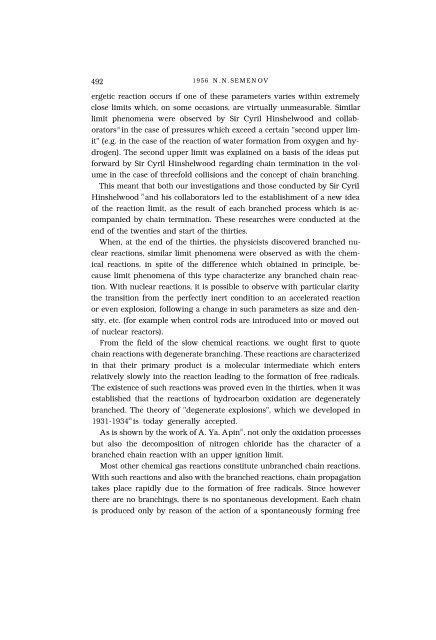Nikolai N. Semenov - Nobel Lecture - Nobelprize.org
Nikolai N. Semenov - Nobel Lecture - Nobelprize.org
Nikolai N. Semenov - Nobel Lecture - Nobelprize.org
You also want an ePaper? Increase the reach of your titles
YUMPU automatically turns print PDFs into web optimized ePapers that Google loves.
492 1956 N.N.SEMENOV<br />
ergetic reaction occurs if one of these parameters varies within extremely<br />
close limits which, on some occasions, are virtually unmeasurable. Similar<br />
limit phenomena were observed by Sir Cyril Hinshelwood and collaborators<br />
19 in the case of pressures which exceed a certain "second upper limit"<br />
(e.g. in the case of the reaction of water formation from oxygen and hydrogen).<br />
The second upper limit was explained on a basis of the ideas put<br />
forward by Sir Cyril Hinshelwood regarding chain termination in the volume<br />
in the case of threefold collisions and the concept of chain branching.<br />
This meant that both our investigations and those conducted by Sir Cyril<br />
Hinshelwood 19 and his collaborators led to the establishment of a new idea<br />
of the reaction limit, as the result of each branched process which is accompanied<br />
by chain termination. These researches were conducted at the<br />
end of the twenties and start of the thirties.<br />
When, at the end of the thirties, the physicists discovered branched nuclear<br />
reactions, similar limit phenomena were observed as with the chemical<br />
reactions, in spite of the difference which obtained in principle, because<br />
limit phenomena of this type characterize any branched chain reaction.<br />
With nuclear reactions, it is possible to observe with particular clarity<br />
the transition from the perfectly inert condition to an accelerated reaction<br />
or even explosion, following a change in such parameters as size and density,<br />
etc. (for example when control rods are introduced into or moved out<br />
of nuclear reactors).<br />
From the field of the slow chemical reactions, we ought first to quote<br />
chain reactions with degenerate branching. These reactions are characterized<br />
in that their primary product is a molecular intermediate which enters<br />
relatively slowly into the reaction leading to the formation of free radicals.<br />
The existence of such reactions was proved even in the thirties, when it was<br />
established that the reactions of hydrocarbon oxidation are degenerately<br />
branched. The theory of "degenerate explosions", which we developed in<br />
1931-1934 20 is today generally accepted.<br />
As is shown by the work of A. Ya. Apin 21 , not only the oxidation processes<br />
but also the decomposition of nitrogen chloride has the character of a<br />
branched chain reaction with an upper ignition limit.<br />
Most other chemical gas reactions constitute unbranched chain reactions.<br />
With such reactions and also with the branched reactions, chain propagation<br />
takes place rapidly due to the formation of free radicals. Since however<br />
there are no branchings, there is no spontaneous development. Each chain<br />
is produced only by reason of the action of a spontaneously forming free
















